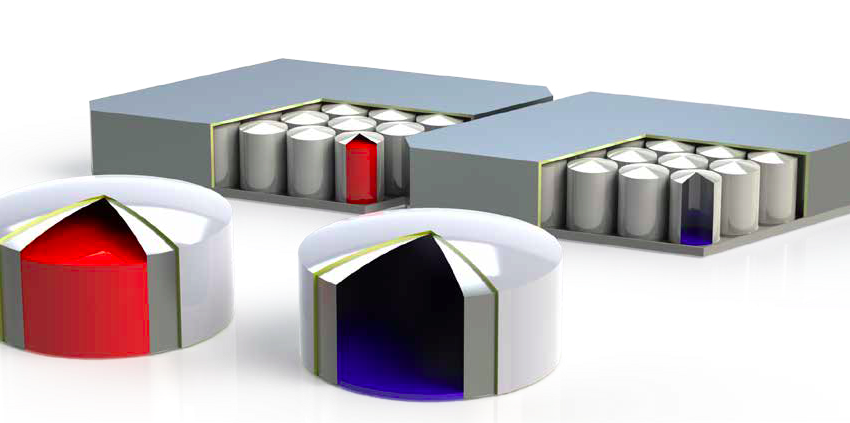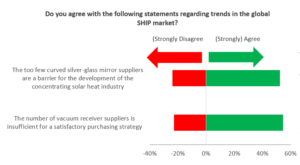Molten salt storage 33 times cheaper than lithium-ion batteries
March 12, 2018
Cost-effective energy storage is key to transitioning to a low-carbon society. Energy can be stored in the form of heat or electricity. A popular storage method for high-temperature thermal applications is a molten salt tank. Fact sheets created by the German Energy Storage Association, or BVES for short, show that molten salt tanks are around 33 times less expensive than electric batteries when it comes to storing a kilowatt-hour in them.
Image: Frenell
Molten salt is currently the most common method to store heat in large CSP plants and provide a constant on-demand supply of solar power without the need for fossil fuel backup systems. Companies such as German-based Frenell, formerly Novatec, offer a turnkey solution combining a solar field and a proprietary direct molten salt technology. This solution can be used, for example, in seawater desalination and enhanced oil recovery. “We have made improvements to our systems, which uses molten salt directly as the heat transfer fluid,” Max Mertins, CTO of Frenell, said. “They allow for a large temperature difference, around 280 K, and lead to heat storage costs ranging from 15 to 25 EUR/kWhth.”
| Operating temperature |
150 to 560 °C |
| Storage capacity |
75 to 200 kWh/m3 |
| Storage capacity |
40 to 110 kWh/ton |
| Storage efficiency |
90 to 99 % |
| Lifetime (cycles) |
10,000 |
| Lifetime |
20 years |
| Daily heat loss |
1 to 5 % |
Main properties of state-of-the-art molten salt storage tanks
Source: BVES
Thermal or electric storage?
A BVES fact sheet published in July 2017 lists capital costs of 25 EUR/kWhth stored in a molten salt tank (see the attached document in German), with the caveat that these specific costs very much depend on the temperature difference and the method of operation, be it direct or indirect via heat exchangers. The figures on the fact sheet range from EUR 25 to 70 EUR/kWhth. The first six demonstration systems which involved large-scale lithium-ion batteries and were set up by energy supplier STEAG cost 833 EUR/kWhel (see the table below).
| Storage technology | Capital costs per kWh capacity | Source of information |
| Molten salt | 25 to 70 EUR/kWhth | BVES (file attached below) |
| Lithium-ion battery | 1,400 EUR/kWhel (EUR 390,000 for 280 kWh) | BVES (file attached below) |
| Lithium-ion battery (pilot project) | 833 EUR/kWhel (EUR 100 million for 120 MWh) | German Aerospace Center |
Battery costs in comparison. The information comes from several sources written in German. To arrive at the figures presented above, capital expenditures have been divided by the number of kilowatt-hours of electricity or heat that can be stored during one cycle. The figures for the battery projects also include the capital costs of the building with air conditioning and fire protection measures.
The table shows molten salt storage to be 33 times less expensive than an electric battery, when comparing the 833 EUR/kWhel to the 25 EUR/kWhth. In the best-case scenario, thermal energy can be stored at around 1/90th of the cost of electricity, when putting the 1,400 EUR/kWhel in relation to the 15 EUR/kWhth.
Dr Günter Schneider, Managing Director of two German companies named Enolcon and Storasol, agreed with the molten salt costs stated in the table and said that “cost comparisons are always tricky because they depend largely on what the underlying calculation entails, for example, whether it includes fans, heat exchangers, pumps or other equipment.” Storasol was founded in 2013, with the intent to design high-temperature thermal energy storage (HTTES) systems based on a technology developed by Enolcon. The latter is a German consultancy and engineering company specialising in project financing and evaluation support for developers of conventional power plants and renewable energy installations.
Schneider added: “The costs in euros per kilowatt-hour also depend on the storage temperature, as this temperature has an influence over how much energy is stored, given the same initial capital expenditures. For example, storing heat at 550 °C could double the storage capacity compared to heat at 400 °C, which means that the costs per kilowatt-hour will be cut in half.”
Storasol´s new modular technology for temperatures of 600 °C or more uses sand or small gravel to store the heat and ambient air to transfer it. “The novel solid bed arrangement of the storage material allows for very fast charging and discharging operations,” Schneider said. “It can lower storage costs to between 15 and 25 EUR/kWhth.” The first of Storasol’s megawatt HTTES systems was put into operation at the University of Bayreuth in late 2015.

Diagram illustrating the principle of the high-temperature thermal energy storage developed by Storasol: A huge surface area reduces the air flow rate to minimise pressure losses throughout the entire system.
Figure: Storasol
Websites of organisations mentioned in this article:
BVES – German Energy Storage Association: http://www.bves.de/english/
Steag: http://www.steag.com
German Aerospace Center: http://www.dlr.de/tt/en/desktopdefault.aspx
Enolcon: http://www.enolcon.com
Storasol: http://www.storasol.eu
Frenell: http://www.frenell.de


